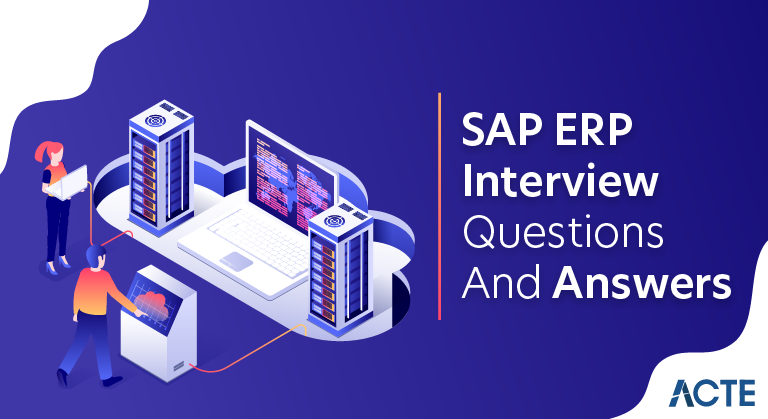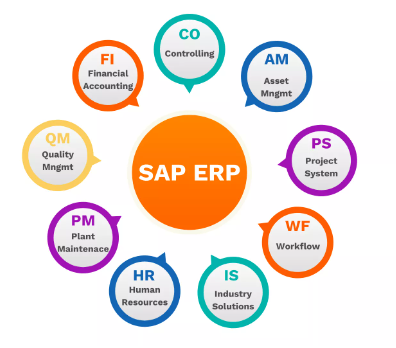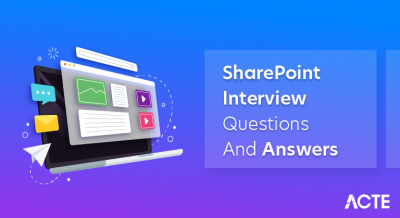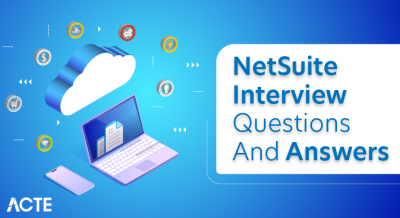
SAP SE, a multinational software corporation based in Germany, developed a comprehensive suite of business software known as SAP ERP (Enterprise Resource Planning). SAP ERP unifies supply chain management, manufacturing, finance, human resources, and customer relationship management into a single platform. It offers businesses a centralised system to improve productivity, simplify processes, and enable data-driven decision-making in real time. Because of its modular design, SAP ERP enables companies to tailor its implementation to meet particular requirements. The system makes information flow within an organisation easier and encourages cooperation between various departments. With a presence throughout the world, SAP ERP has established itself as the go-to option for medium-sized to large businesses looking for an integrated, scalable solution to efficiently manage their business processes.
1. What is SAP HANA, and how does it differ from traditional databases?
Ans:
SAP HANA is an in-memory database that processes data at unprecedented speeds, enabling real-time analytics. Unlike traditional databases that rely on disk storage, HANA stores and retrieves data from RAM, significantly reducing latency. This architecture boosts performance, allowing organizations to analyze large datasets instantly and make informed decisions promptly.
2. Explain the significance of SAP Fiori in the SAP user experience.
Ans:
SAP Fiori revolutionizes the user interface by providing a responsive and intuitive design. It enhances accessibility, allowing users to interact with SAP applications seamlessly across devices. Fiori’s role-based approach tailors the user experience, optimizing workflows and improving productivity. This design philosophy ensures a consistent and user-friendly interface, transforming complex business processes into streamlined, user-centric interactions.
3. How does SAP S/4HANA leverage the in-memory computing capabilities of SAP HANA?
Ans:
SAP S/4HANA harnesses the power of SAP HANA’s in-memory computing to revolutionize enterprise resource planning. The platform enables real-time data processing, eliminating traditional batch processing limitations. With HANA’s speed, S/4HANA delivers instant insights, accelerates transaction processing, and facilitates advanced analytics. This integration fundamentally transforms business processes, ensuring organizations operate with unprecedented efficiency and agility.
4. Discuss the role of SAP ABAP in customization and enhancement.
Ans:
SAP Advanced Business Application Programming (ABAP) is the cornerstone of SAP’s customization and enhancement capabilities. ABAP allows developers to create custom reports, interfaces, and enhancements, tailoring SAP applications to meet specific business requirements. With ABAP, organizations can adapt SAP functionalities, ensuring seamless integration of unique business processes and optimizing the ERP system according to the company’s evolving needs.
5. What is SAP BW, and how does it support business intelligence?
Ans:
SAP Business Warehouse (BW) is a comprehensive data warehousing solution designed for business intelligence and reporting. It facilitates the extraction, transformation, and loading (ETL) of data from various sources into a centralized repository. BW’s multidimensional data modeling and analytics capabilities enable users to generate meaningful insights. By supporting data consolidation and offering robust reporting tools, SAP BW empowers organizations to make informed decisions based on a unified and comprehensive view of their data.
6. What is SAP ERP?
Ans:
Finance, HR, and customer relations are just a few of the important business processes that SAP ERP, created by SAP SE, integrates and optimises. Because of its modular design, it is customizable and promotes departmental communication. SAP ERP is well known for its capacity to offer real-time insights, improving decision-making and operational effectiveness for companies all over the world.

7. Explain the purpose and significance of SAP Solution Manager.
Ans:
SAP Solution Manager is a centralized platform that oversees the entire SAP landscape’s lifecycle. It supports various phases, from implementation and configuration to ongoing operations and monitoring. Solution Manager ensures optimal system performance, aids in project management, and facilitates seamless integration with other SAP modules. This tool is indispensable for maintaining the health and efficiency of SAP landscapes, promoting best practices, and ensuring a smooth end-to-end experience for users.
8. How does SAP support batch input processing for mass data uploads?
Ans:
SAP employs Batch Input Sessions as a mechanism for processing large volumes of data in batch mode. This approach facilitates the efficient upload of data into the system by collecting and validating data in sessions. The data is then input into the SAP system in batches, ensuring accuracy and consistency. This batch input processing method streamlines the handling of extensive datasets, providing a systematic and controlled approach for data migration and maintenance.
9. Discuss the integration capabilities of SAP ERP with external systems.
Ans:
SAP ERP offers robust integration capabilities, allowing seamless communication with external systems. Technologies such as SAP Process Integration/Process Orchestration (PI/PO) and Remote Function Call (RFC) enable data exchange between SAP and external applications. This integration ensures real-time information flow, supporting interoperability and collaboration across diverse system landscapes. Organizations can achieve end-to-end business processes by connecting SAP ERP with third-party solutions, promoting efficiency and agility in their operations.
10. Explain the SAP R/3 architecture.
Ans:
The three-tiered SAP R/3 architecture is intended for enterprise resource planning. Data is stored in the database tier, business logic and processes are managed by the application tier, and user interfaces are handled by the presentation tier. Through graphical user interfaces, the presentation layer communicates with users, while the application layer uses a central data repository to carry out business processes. Scalability and flexibility are made possible by this modular architecture, which lets businesses adjust to their unique requirements.
11. Differentiate between SAP ECC and SAP S/4HANA.
Ans:
| Feature | SAP ECC | SAP S/4HANA | |
| Database Structure | Relational Database (e.g., Oracle, SAP HANA) |
SAP HANA (In-memory database) | |
| User Interface | Classic GUI (Graphical User Interface) | Fiori UX (Modern, Responsive Interface) | |
| Data Processing | Batch-Oriented | Real-time Processing | |
| Data Model | Traditional Row-based Data Model | Simplified, Columnar Data Model |
12. What role does SAP GRC play in managing governance, risk, and compliance?
Ans:
SAP Governance, Risk, and Compliance (GRC) is a critical solution for organizations to manage governance, risk, and compliance processes effectively. GRC provides tools for defining and enforcing internal controls, ensuring adherence to regulatory requirements. With features like access control, process control, and risk management, SAP GRC enhances transparency and accountability. By centralizing GRC activities, organizations can systematically mitigate risks, maintain compliance, and establish a solid foundation for effective governance.
13. Explain the purpose of SAP BusinessObjects in reporting and analytics.
Ans:
SAP BusinessObjects is a comprehensive suite of applications designed for reporting, analytics, and business intelligence. It enables organizations to create, analyze, and share meaningful insights derived from their data. With tools like Crystal Reports, Web Intelligence, and Lumira, BusinessObjects empowers users to generate dynamic and interactive reports. This suite’s capabilities extend to ad-hoc reporting, data visualization, and performance optimization, providing a robust framework for decision-makers to extract actionable intelligence from their SAP ERP system.
14. How does SAP handle security and user authorization within the system?
Ans:
SAP employs a role-based security model to manage user authorization efficiently. Users are assigned roles, each containing a set of authorizations defining their access rights. Profiles further fine-tune authorizations, ensuring users only have the necessary permissions. SAP’s Security Audit Log monitors user activities, enhancing transparency and accountability. By adopting this granular approach to security, organizations can safeguard their SAP ERP systems, protect sensitive data, and enforce a robust access control mechanism.
- IWebiReport report = crystalEnterprise.getInstance().getInfoStore().getFactory(“”, “webi”).openDocument(“YourWebiDocumentID”);
- IWebiResults results = report.getResults();
- // Perform operations on results (e.g., retrieve data)
- report.closeDocument();
15. Discuss the role of SAP EWM in optimizing warehouse processes.
Ans:
SAP Extended Warehouse Management (EWM) is instrumental in optimizing and streamlining warehouse operations. EWM provides advanced functionalities such as slotting, task interleaving, and wave management. It supports real-time monitoring of warehouse activities, enhancing visibility and control. By integrating seamlessly with SAP ERP, EWM ensures end-to-end logistics management, from order creation to fulfillment. This module’s automation and optimization capabilities contribute to increased efficiency, reduced errors, and improved overall warehouse performance.
16. Explain the integration between SAP CRM middleware and backend systems.
Ans:
The SAP CRM middleware serves as a bridge between SAP CRM and backend systems, facilitating bidirectional data synchronization. This middleware ensures real-time updates of customer information and transaction data, enhancing data consistency across the enterprise. By supporting seamless communication between systems, it enables organizations to maintain a unified and accurate view of customer-related data. This integration is crucial for businesses looking to deliver a consistent and personalized customer experience while leveraging the capabilities of both SAP CRM and backend ERP systems.
17. How does SAP support data archiving to enhance system performance?
Ans:
SAP Data Archiving is a process that involves moving historical data to external storage to optimize system performance. Archiving old and rarely accessed data helps reduce database size and improves response times. Even though the archived data is stored externally, it remains accessible for reporting and analysis. This approach ensures that organizations can maintain system efficiency without compromising data availability. SAP’s Data Archiving functionality is a valuable tool for managing data growth, ensuring optimal performance, and meeting long-term storage requirements.
18. Discuss the role of SAP APO in optimizing supply chain planning.
Ans:
SAP Advanced Planning and Optimization (APO) is a module dedicated to enhancing supply chain planning processes. APO provides functionalities such as Demand Planning, Supply Network Planning, and Production Planning, enabling organizations to optimize their end-to-end supply chain operations. By supporting collaborative planning and real-time data analysis, APO helps organizations achieve greater accuracy in demand forecasting, efficient allocation of resources, and improved overall supply chain efficiency. This module is instrumental in aligning planning processes with business objectives, reducing lead times, and ensuring optimal inventory levels.
19. What is the significance of SAP MDG in master data management?
Ans:
SAP Master Data Governance (MDG) plays a crucial role in centralizing and harmonizing master data across an organization. MDG ensures data consistency, accuracy, and adherence to data governance policies. By providing a standardized approach to master data maintenance, organizations can avoid data duplication and errors. MDG supports data quality rules and workflows, enabling efficient data creation, modification, and distribution across the enterprise. This module’s capabilities contribute to the creation of a single, reliable source of truth for master data, ensuring business processes operate with integrity and precision.
20. Explain the purpose of SAP EHS in managing environment, health, and safety.
Ans:
SAP Environment, Health, and Safety (EHS) modules are designed to address organizations’ requirements for managing environmental, health, and safety aspects. This module supports compliance with regulatory standards, tracks incidents and accidents, and ensures adherence to safety protocols. With functionalities for product safety, hazardous substance management, and occupational health, SAP EHS enables organizations to create a safer and more sustainable work environment. By providing tools for risk assessment and reporting, this module contributes to organizations’ overall commitment to environmental and employee well-being.
21. Discuss the role of SAP CDS in data modeling for SAP HANA.
Ans:
Core Data Services (CDS) is a key component in SAP HANA for defining semantically rich data models. CDS allows developers to create data definitions that are reusable across different applications, supporting the creation of database views, associations, and annotations. By enhancing data modeling capabilities in ABAP development, CDS enables developers to create efficient and optimized data structures. This approach promotes consistency, reusability, and performance optimization in data modeling for SAP HANA, contributing to the overall efficiency of application development and deployment.
22. How does SAP support currency conversion in financial transactions?
Ans:
SAP utilizes configurable exchange rates for handling currency conversion in financial transactions. Exchange rates are set up in the system based on predefined rules and factors such as daily rates or monthly averages. During financial postings, SAP dynamically applies the relevant exchange rates to ensure accurate and up-to-date currency conversions. This flexibility allows organizations to adapt to varying exchange rate scenarios and align financial reporting with international standards. By providing transparent and configurable currency conversion mechanisms, SAP enables organizations to conduct global financial transactions seamlessly.
23. Explain the integration capabilities of SAP ERP with third-party analytics tools.
Ans:
SAP ERP offers robust integration capabilities with third-party analytics tools, enabling organizations to leverage a diverse range of analytics solutions. SAP supports integration through Open Data Protocol (OData) services and APIs, facilitating the extraction of data from SAP systems. This integration allows organizations to use external analytics tools such as SAP BusinessObjects, Tableau, or Power BI for advanced data analysis and reporting. By providing real-time and batch data extraction options, SAP ERP ensures flexibility in choosing analytics solutions that best suit the organization’s analytical and reporting needs.
24. Discuss the role of SAP EHP (Enhancement Package) in system enhancement.
Ans:
SAP Enhancement Packages (EHPs) are bundles of new functionalities and enhancements designed to augment SAP ERP systems without necessitating a complete upgrade. EHPs provide organizations with the ability to adopt additional features, industry-specific solutions, and improvements in existing modules. By offering a modular approach to system enhancement, EHPs allow organizations to stay current with the latest SAP advancements and innovations. This flexibility in adopting new technologies ensures that SAP ERP systems continue to evolve alongside changing business requirements, promoting longevity and adaptability.
25. How does SAP support parallel processing in ABAP programs?
Ans:
SAP supports parallel processing in ABAP programs through various mechanisms, allowing developers to optimize the execution of time-intensive operations. Developers can utilize keywords such as “Parallel Cursor” and “Parallel Blocks” in ABAP programs to implement parallel processing. This approach enables the simultaneous execution of multiple tasks, distributing the workload across available resources and improving overall performance. By leveraging parallel processing in ABAP programs, organizations can harness the full potential of their SAP systems, ensuring efficient utilization of system resources and faster execution of critical business processes.
26. Discuss the concept of SAP Fiori Elements and their impact on application development.
Ans:
SAP Fiori Elements represent a set of pre-built UI patterns that significantly simplify and accelerate application development. These elements, including List Report, Object Page, Overview Page, and Analytical List Page, provide ready-to-use templates for common application scenarios. Fiori Elements reduce development effort by offering standardized UI building blocks that align with Fiori design principles. This approach ensures consistency and a superior user experience across applications. By leveraging Fiori Elements, developers can streamline the development process, focusing on business logic and functionality while delivering applications with a modern, responsive, and user-friendly interface.
27. Explain the purpose of SAP Smart Forms in document generation.
Ans:
SAP Smart Forms serve as a powerful tool for creating and maintaining forms within the SAP environment. These forms are utilized for generating business documents such as invoices, purchase orders, and delivery notes. Smart Forms provide a user-friendly interface for designing and customizing document layouts, incorporating dynamic data elements. By offering a comprehensive set of formatting options, conditional logic, and data binding capabilities, SAP Smart Forms empower organizations to tailor their business documents to meet specific requirements. This flexibility ensures that printed or electronically generated documents align with the organization’s branding and communication standards.
28. Discuss the concept of SAP NetWeaver and its role in system integration.
Ans:
SAP NetWeaver is an integrated technology platform designed to serve as the foundation for SAP applications. It plays a pivotal role in system integration by providing tools and services that facilitate seamless communication between different systems within an organization. NetWeaver supports the integration of diverse technologies, platforms, and applications, ensuring interoperability. By offering capabilities such as Process Integration (PI) and Business Process Management (BPM), SAP NetWeaver enables organizations to create a cohesive and efficient IT landscape. This integrated approach enhances collaboration, data exchange, and business process orchestration across the enterprise.
29. What is the significance of SAP HANA in the context of SAP ERP?
Ans:
SAP HANA revolutionizes SAP ERP by providing an in-memory database, accelerating data processing. It enhances performance, enabling real-time analytics and decision-making. HANA’s columnar storage and data compression contribute to efficient data retrieval, transforming the traditional ERP landscape.
30. How does SAP Fiori improve user experience in SAP applications?
Ans:
SAP Fiori enhances user experience by offering a responsive, role-based design. Fiori streamlines workflows, making SAP applications more intuitive. Its focus on simplicity and mobility optimizes user interaction, improving overall productivity.
31. Explain the integration between SAP S/4HANA and SAP BW.
Ans:
SAP S/4HANA seamlessly integrates with SAP BW, providing advanced analytics. S/4HANA serves as a data source for BW, enabling comprehensive reporting and analysis. This integration ensures a unified view of operational and analytical data.
32. What role does ABAP play in SAP ERP customization?
Ans:
ABAP (Advanced Business Application Programming) is SAP’s programming language for ERP customizations. It enables developers to create tailored reports, interfaces, and enhancements. ABAP ensures adaptability to unique business processes within the ERP framework.
33. Discuss the purpose of SAP Solution Manager in an ERP landscape.
Ans:
SAP Solution Manager is essential for managing the entire ERP lifecycle. It supports implementation, monitoring, and optimization. Solution Manager ensures system health, compliance, and efficient project management.
34. How does SAP ERP handle data archiving to optimize system performance?
Ans:
SAP ERP employs data archiving to optimize performance by moving historical data to external storage. Archiving enhances system responsiveness by reducing database size. Archived data remains accessible for reporting, ensuring data availability.
35. Explain the significance of SAP GRC in SAP ERP security.
Ans:
SAP Governance, Risk, and Compliance (GRC) ensures secure SAP ERP environments. It centralizes control, monitors risks, and ensures compliance with regulatory standards. GRC’s access controls enhance system security and data integrity.
36. What is the role of SAP PI/PO in SAP ERP integration?
Ans:
SAP Process Integration/Process Orchestration (PI/PO) facilitates seamless integration within SAP ERP. It supports data exchange between SAP and external systems, enabling interoperability and efficient communication.
37. Discuss the impact of SAP BusinessObjects in ERP reporting.
Ans:
SAP BusinessObjects transforms ERP reporting by offering a suite of tools for analytics and reporting. It includes solutions like Crystal Reports and Web Intelligence, providing dynamic, interactive reports for informed decision-making.
38. How does SAP ERP manage currency conversion in financial transactions?
Ans:
SAP ERP manages currency conversion by utilizing configurable exchange rates. Exchange rates are set based on predefined rules and factors, ensuring accuracy in financial transactions.
39. Explain SAP EWM’s role in optimizing warehouse processes within SAP ERP.
Ans:
SAP Extended Warehouse Management (EWM) optimizes warehouse processes by providing advanced features like slotting and wave management. EWM integrates seamlessly with SAP ERP, ensuring end-to-end logistics management.
40. Discuss the concept of SAP MDG in SAP ERP master data management.
Ans:
SAP Master Data Governance (MDG) centralizes master data across SAP ERP. MDG ensures data consistency, adheres to data governance policies, and avoids duplication.
41. How does SAP ERP support parallel processing in ABAP programs?
Ans:
SAP ERP supports parallel processing in ABAP programs through keywords like “Parallel Cursor” and “Parallel Blocks.” This enhances execution speed by distributing tasks across available resources.
42. Explain the integration capabilities of SAP ERP with third-party analytics tools.
Ans:
SAP ERP integrates with third-party analytics tools via Open Data Protocol (OData) services and APIs. This allows the extraction of data for analysis in tools like SAP BusinessObjects, Tableau, or Power BI.
43. Discuss the role of SAP EHP in enhancing SAP ERP systems.
Ans:
SAP Enhancement Packages (EHPs) enhance SAP ERP systems by providing additional functionalities without a complete upgrade. EHPs offer modular improvements, allowing organizations to adopt new features incrementally.
44. What is the significance of SAP Fiori Elements in application development?
Ans:
SAP Fiori Elements offer pre-built UI patterns, simplifying and accelerating application development. These elements align with Fiori design principles, ensuring a consistent user experience.
45. Explain the purpose of SAP Smart Forms in document generation within SAP ERP.
Ans:
SAP Smart Forms play a crucial role in document generation within SAP ERP by providing a user-friendly and flexible tool for designing and formatting business documents. These documents can include invoices, purchase orders, and other output formats. SAP Smart Forms enable the creation of visually appealing and customized layouts, incorporating dynamic data from SAP systems.
46. Discuss the role of SAP NetWeaver in SAP ERP system integration.
Ans:
SAP NetWeaver serves as the foundation for SAP ERP system integration, providing tools and services for seamless communication between different systems. NetWeaver supports interoperability, creating an efficient IT landscape.
47. How does SAP ERP handle security and user authorization?
Ans:
SAP ERP employs a role-based security model for managing user authorization. Roles define access rights, ensuring users have only necessary permissions. Security Audit Log monitors activities, enhancing transparency and accountability.
48. What is the purpose of SAP APO in SAP ERP supply chain planning?
Ans:
SAP Advanced Planning and Optimization (APO) enhances supply chain planning by providing functionalities like Demand Planning and Supply Network Planning. APO optimizes end-to-end supply chain operations.
49. Explain the integration between SAP CRM middleware and backend systems.
Ans:
SAP CRM middleware facilitates bidirectional data synchronization between SAP CRM and backend systems. This ensures real-time updates, supporting a unified view of customer-related data.
50. Discuss the concept of SAP BW in data warehousing for SAP ERP.
Ans:
SAP Business Warehouse (BW) is a data warehousing solution for SAP ERP, enabling extraction, transformation, and loading (ETL) of data. BW supports data consolidation and advanced analytics.
51. How does SAP ERP support multilevel ATP in Sales and Distribution?
Ans:
SAP ERP supports multilevel ATP (Available-to-Promise) in Sales and Distribution by offering a comprehensive solution to manage and optimize product availability across various levels of the supply chain. This functionality considers stock levels, existing orders, and production constraints to provide real-time information on product availability. It enables businesses to make reliable delivery promises to customers by considering the entire supply chain network.
52. Explain the functionalities of SAP MDM in SAP ERP.
Ans:
SAP Master Data Management (MDM) centralizes and harmonizes master data in SAP ERP. MDM ensures data consistency, supports governance, and integrates with other SAP modules.
53. Discuss the role of SAP EHS in managing environment, health, and safety in SAP ERP.
Ans:
SAP Environment, Health, and Safety (EHS) in SAP ERP manages environmental, health, and safety aspects. EHS supports compliance, incident tracking, and risk management for a safer work environment.
54. What is the significance of SAP Fiori in SAP S/4HANA?
Ans:
SAP Fiori is a key component of SAP S/4HANA since it provides a contemporary and user-friendly interface for SAP applications, acting as the UX design approach. By providing a responsive, customised, and consistent user experience across devices, Fiori improves user engagement. Fiori’s contribution to SAP S/4HANA goes beyond aesthetics; it also consists of role-based applications that simplify and optimise a range of business processes.
55. Explain the purpose of SAP NetWeaver.
Ans:
SAP NetWeaver is an integrated technology platform that serves as the foundation for many SAP applications. It facilitates the integration of various systems and enables seamless communication.
56. Describe the role of SAP HANA in SAP ERP.
Ans:
HANA is an in-memory database that accelerates data processing in real-time. Improves performance by storing and retrieving data faster than traditional databases.
57. What is the SAP ASAP methodology?
Ans:
- ASAP (Accelerated SAP) is a methodology for implementing SAP ERP projects.
- Phases include Project Preparation, Business Blueprint, Realization, Final Preparation, and Go-Live & Support.
58. How does SAP handle batch input in data processing?
Ans:
SAP employs a Batch Input method to manage large-scale data processing efficiently. Users record manual transactions, and these recordings are then processed in batches, enabling the streamlined upload of extensive data sets into the SAP system. This approach proves valuable for tasks like bulk data entry or updates, offering a structured and automated solution for handling significant volumes of information. The Batch Input method enhances data processing speed and accuracy within the SAP environment.
59. Explain the purpose of the SAP Transport Management System (TMS).
Ans:
- TMS is used for managing the transport of changes between SAP systems.
- Ensures a controlled and organized movement of configuration and development objects.
60. Differentiate between Master Data and Transaction Data in SAP.
Ans:
Master data in SAP encompasses stable, foundational information like customers and products. It serves as a reference for transactions. Transaction data, on the other hand, consists of dynamic records generated during business activities, such as sales orders and invoices. This distinction is vital for maintaining data accuracy and supporting effective business processes in SAP.
61. What is the purpose of SAP BW (Business Warehouse)?
Ans:
Business Warehouse, or SAP BW, is a data warehousing solution that helps an organisation gather, combine, and evaluate business data from multiple sources. Its main goal is to give users access to a centralised reporting and data analysis platform so they can make well-informed business decisions. SAP BW unifies information from various systems, formats it uniformly, and keeps it organised in a structured data warehouse.
62. Explain the significance of SAP IDoc (Intermediate Document).
Ans:
SAP IDoc, or Intermediate Document, plays a crucial role in facilitating communication and data exchange between different systems within an SAP landscape. It serves as a standardized format for exchanging business documents between SAP and non-SAP systems, ensuring seamless integration and interoperability. IDocs are essential for supporting various business processes such as order processing, inventory management, and financial transactions.
63. How does SAP handle security and user authorization?
Ans:
- SAP uses profiles and roles to control user access.
- Security is managed through the assignment of authorizations based on roles.
64. Discuss the importance of SAP BusinessObjects in reporting.
Ans:
SAP BusinessObjects is a leading reporting solution that offers an extensive tool set for managing, generating, and distributing business intelligence reports. Its capabilities, which include interactive dashboards, ad hoc reporting, and data visualisation, let businesses draw actionable conclusions from their data. BusinessObjects’ capacity to establish connections with multiple data sources guarantees that decision-makers receive precise and prompt information, promoting well-informed decision-making.
65. What is the purpose of the SAP Solution Manager?
Ans:
- Solution Manager is a centralized platform for managing and monitoring SAP systems.
- It supports the entire lifecycle of SAP applications, from implementation to operations.
66. Explain the integration between SAP ERP and external systems.
Ans:
Data and processes are seamlessly exchanged as part of the SAP ERP integration with external systems. SAP offers a range of integration tools, including Application Programming Interfaces (APIs), SAP Cloud Platform Integration, and SAP Process Integration (PI/PO). Order processing, inventory control, and financial transactions are just a few of the features that the integration facilitates, guaranteeing smooth operations and the best possible utilisation of a variety of software programmes across the IT landscape of the company.
67. Discuss the role of SAP ABAP in SAP ERP.
Ans:
- ABAP (Advanced Business Application Programming) is a programming language used for SAP customizations and enhancements.
- It allows developers to create reports, interfaces, and enhancements.
68. How does SAP handle currency conversion in financial transactions?
Ans:
- SAP uses exchange rates configured in the system.
- Currency conversion is performed during financial postings based on these rates.
69. Explain the concept of SAP Data Archiving.
Ans:
SAP Data Archiving is a strategy employed to manage the volume of data stored in an SAP system efficiently. It involves transferring historical and less frequently accessed data from the active database to a secure, long-term storage area. This process helps optimize system performance, reduce database size, and enhance overall system responsiveness.
70. Describe the purpose of SAP Smart Forms.
Ans:
Smart Forms is a tool for creating and maintaining forms in SAP. It enables the design and printing of business documents such as invoices and purchase orders.
71. What is the role of SAP GUI (Graphical User Interface) in SAP ERP?
Ans:
SAP GUI (Graphical User Interface) serves as the interface between users and the SAP ERP system, facilitating intuitive and interactive interactions. It provides a graphical representation of SAP applications, enabling users to access and navigate various modules seamlessly. SAP GUI is essential for executing transactions, entering data, and retrieving information from the SAP system. Its role is to present a user-friendly environment for interacting with the robust functionalities of SAP ERP, ensuring efficient data input, retrieval, and transaction processing across different business modules within the enterprise.
72. Explain the use of SAP Business Workflow.
Ans:
- Business Workflow automates and streamlines business processes in SAP.
- ensures tasks are routed to the right individuals at the right time for efficient processing.
73. How does SAP support multi-language functionality?
Ans:
SAP supports multi-language functionality through its internationalization features, allowing users to interact with the system in their preferred language. Language-specific data, such as labels and messages, is stored in language tables, and users can switch between languages dynamically. SAP also provides translation tools to adapt custom developments and user interfaces to various languages, ensuring a seamless and globally accessible experience for users across different linguistic preferences within the SAP ERP system.
74. Discuss the role of SAP CRM (Customer Relationship Management).
Ans:
- SAP CRM is a module that manages customer-related processes and interactions.
- It includes functionalities for sales, marketing, and service.
75. What are SAP Best Practices, and how are they used?
Ans:
SAP Best Practices are pre-configured, industry-specific templates and guidelines provided by SAP to expedite and optimize the implementation of SAP solutions. They encapsulate proven methodologies, processes, and configurations that align with industry standards and regulations. These practices serve as a reference framework, guiding organizations through the deployment of SAP systems by offering ready-made solutions for common business scenarios.
76. Explain the concept of SAP HANA.
Ans:
- SAP HANA is an in-memory database and application platform.
- It allows real-time data processing and analytics.
- Uses column-based storage for faster data retrieval.
- Enables high-performance computing for complex queries.
77. What is the purpose of SAP Fiori Launchpad?
Ans:
The SAP Fiori Launchpad serves as a central, personalized entry point for users accessing SAP applications and analytics. It offers a unified, intuitive interface that aggregates various Fiori apps, providing a consistent and responsive user experience across devices. The launchpad supports role-based access, allowing users to access relevant applications based on their responsibilities.
78. Discuss the role of SAP S/4HANA in digital transformation.
Ans:
- S/4HANA is SAP’s next-generation ERP suite.
- Enables organizations to run their business processes in real-time.
- Integrates advanced technologies like AI and machine learning for intelligent automation.
- Simplifies data models and accelerates decision-making.
79. What is SAP LSMW (Legacy System Migration Workbench)?
Ans:
SAP LSMW, or Legacy System Migration Workbench, is a tool designed to simplify and expedite the data migration process when transferring data from legacy systems to SAP systems. It provides a structured framework for mapping, converting, and importing data into SAP, offering predefined templates and rules for various data objects. LSMW supports multiple data sources, such as Excel or legacy databases, and facilitates the creation and execution of data migration projects through a step-by-step process.
80. Explain the significance of SAP BAPIs (Business Application Programming Interfaces).
Ans:
SAP BAPIs (Business Application Programming Interfaces) are crucial for enabling seamless communication between different SAP systems and external applications. They provide a standardized interface for accessing SAP business processes and data, allowing external programs to integrate efficiently with SAP solutions. BAPIs ensure consistency, reusability, and scalability in system interactions, serving as a foundation for building robust and interoperable applications within the SAP ecosystem.
81. How does SAP support parallel processing in ABAP programs?
Ans:
- SAP provides parallel processing options using parallel work processes.
- Developers can use keywords like “Parallel Cursor” and “Parallel Blocks” in ABAP programs.
- Allows the execution of multiple tasks simultaneously for improved performance.
- Ensures efficient utilization of system resources during data processing.
82. Discuss the concept of SAP BRFplus (Business Rule Framework plus).
Ans:
SAP BRFplus (Business Rule Framework plus) is a powerful tool within the SAP ecosystem that enables the modeling and management of business rules in a flexible and user-friendly manner. It allows business users to define and modify rules without extensive technical knowledge, fostering agility in adapting to changing business requirements. BRFplus supports various rule types, including decision tables, formulas, and expressions, providing a versatile framework for implementing complex decision-making processes.
83. What is SAP PI/PO (Process Integration/Process Orchestration)?
Ans:
SAP PI/PO (Process Integration/Process Orchestration) is an integration platform that facilitates seamless communication and data exchange between different systems within an organization. It serves as a middleware solution, connecting diverse applications and enabling them to work together cohesively. SAP PI focuses on integrating processes, transforming data formats, and ensuring reliable message flow.
84. Explain the purpose of SAP GRC (Governance, Risk, and Compliance).
Ans:
SAP GRC, which stands for Governance, Risk, and Compliance, is a comprehensive set of tools and procedures that companies can use to manage risks, comply with regulations, and improve governance in general. It offers a centralised platform for overseeing and managing authorizations and access, keeping an eye on business operations, and making sure industry- and legally-specific rules are followed.
85. What is the role of SAP MDM (Master Data Management) in ERP?
Ans:
- MDM is used to centralize and harmonize master data across an organization.
- Ensures consistency and accuracy of master data, such as customer and product information.
- Supports data governance by defining data quality rules and policies.
- Integrates with other SAP modules for a unified view of master data.
86. Discuss SAP EWM (Extended Warehouse Management) functionalities.
Ans:
SAP Extended Warehouse Management (EWM) offers advanced functionalities for optimizing warehouse processes and improving overall supply chain efficiency. Key features include advanced slotting for optimized storage, comprehensive inventory management with real-time visibility, and support for complex warehouse tasks such as cross-docking and yard management.
87. How does SAP handle material valuation in the MM module?
Ans:
The integration of the Valuation Area, Valuation Classes, and Price Control indicators manages material valuation in SAP’s Material Management (MM) module. A particular organisational level for valuation, like a plant or company code, is represented by the Valuation Area. Valuation classes classify materials into groups based on how accounting transactions affect the financial statements in order to facilitate valuation.
88. Explain the purpose of SAP Solution Composer.
Ans:
SAP Solution Composer serves as a tool within the SAP landscape to streamline and accelerate the design and documentation of software solutions. It allows users to create comprehensive solution blueprints by defining business processes, requirements, and system landscapes in a structured manner. This tool supports collaboration among project stakeholders and enhances communication by providing a unified platform for capturing and sharing solution details.
89. Discuss the role of SAP APO (Advanced Planning and Optimization).
Ans:
- APO is a module for optimizing supply chain planning and execution.
- Includes functionalities like Demand Planning, Supply Network Planning, and Production Planning.
- Enhances collaboration among different stakeholders in the supply chain.
- Supports the creation of integrated and demand-driven supply chain strategies.
90. How does SAP support data migration during system upgrades?
Ans:
During system upgrades, SAP provides various tools and methodologies to support data migration. The Data Migration Workbench (DMW) and tools like LSMW (Legacy System Migration Workbench) assist in transferring data from legacy systems to the upgraded SAP environment. SAP also offers services like SAP S/4HANA Migration Cockpit for a streamlined migration process.






